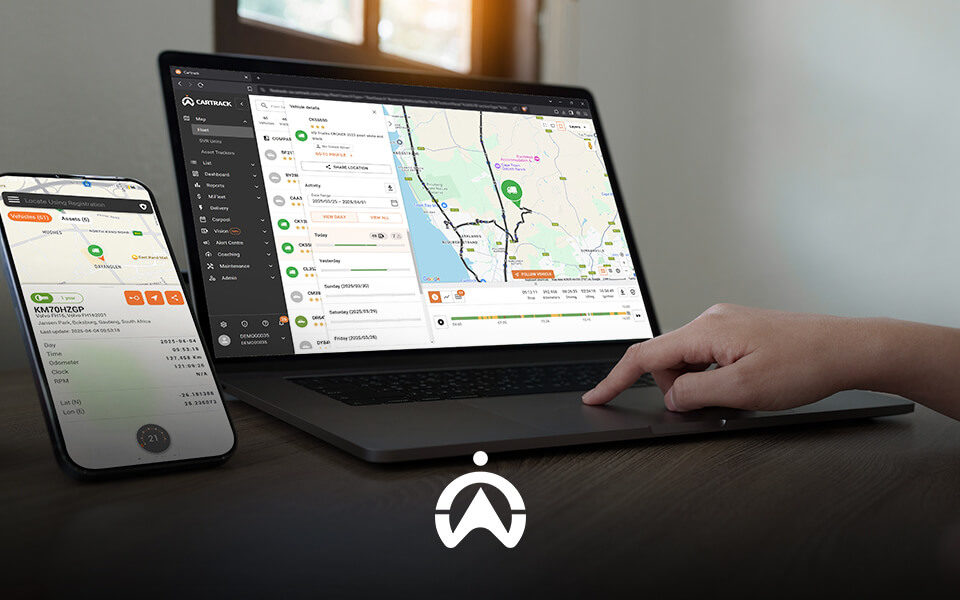Enterprise Fleet Management: How to Manage Large Fleets Successfully
Large fleets can bring big returns, but also big headaches. From fuel costs to driver safety, keeping everything running smoothly can feel like an impossible feat.
The secret is enterprise fleet management—your large fleet’s solution to efficiency, safety, and ultimate control.
Let’s find out what makes fleet management the key to a successful large fleet.
What is an enterprise fleet?
A fleet is a group of vehicles typically owned by one business. These vehicles, which can be anything from trucks and taxis to bakkies, are used for transportation, logistics, or commercial operations. Fleets come in all industries, shapes, and sizes, but what makes an enterprise fleet stand out is its size. While the size of an enterprise fleet can vary, it is typically defined as having at least 15 vehicles. But what are the key differences between a small fleet and an enterprise fleet? Let’s explore these.
Whether 5 or 500 vehicles, fleets come in all industries, shapes, and sizes. One thing both small and large fleets have in common is the key components needed for successful management.
The keys to successful enterprise fleet management
While no two fleets are exactly alike, there are key tools every fleet should be utilising to ensure their success.
Let’s take a look at them:
1. Proactive management, not reactive:
Proactive management is a crucial part of running a successful fleet, as it allows you to address issues before they snowball into costly problems. You must adopt a proactive management style instead of a reactive one, which can negatively impact fleet efficiency, profitability, and productivity. Let’s look at a quick comparison of the two.
2. Data-driven decision-making:
Relying on intuition and playing the guessing game when it comes to running your fleet does more harm than good. This is where data-driven decision-making comes in—the process of using information gathered from various sources to make informed choices about your fleet operations.
Data-driven decision-making is built on the following concepts:
- Data collection: Acting as the foundation for data-driven decision-making, data collection refers to gathering data from various sources, such as vehicle telematics, maintenance records, and dispatch information, with collected data serving as raw material for insights.
- Data analysis: Analysing the data that has been collected to identify trends and patterns in your fleet.
- Actionable insights: Turning the collected data into actions that can be used to improve fleet efficiency through data-driven decision-making.
3. Adaptability:
Adaptability is important for running a successful fleet in the ever-changing world of fleet management. It is being flexible and resourceful in the face of unexpected situations or evolving needs. Customer demands and industry trends can change rapidly, so a fleet must adapt its services or offerings to these trends.
John, for example, has customers who are now demanding estimated times of arrival for deliveries. If John cannot adapt to and meet this demand, he risks losing his customers, negatively impacting his business. This adaptability also applies to technological advancements.
Whether you own a small or large fleet, the above tools are crucial for your fleet’s success. However, it is also important to remember that the size of your fleet determines what solutions you need to prioritise more. Fleet size impacts the challenges faced, so the solutions should be tailored depending on your fleet’s individual needs.

What challenges do large fleets face?
Large fleets differ from smaller ones not only in size but also in terms of the challenges they face. As we unpack these challenges with some contextual statistics and facts below, things are about to get interesting.
Fuel management: Fuel is a major fleet expense, and South Africa’s fluctuating fuel prices can significantly impact large fleets. Research shows that most fleets can spend about 24% of their budget on fuel, so a minor price hike automatically becomes a substantial fuel budget increase. Manually keeping track of how much fuel all your fleet vehicles are consuming can be quite challenging and time-consuming.
- Vehicle maintenance: Keeping a large number of vehicles operational requires constant attention. This is crucial because one vehicle’s breakdown can impact the efficiency of the entire fleet operation. On top of that, accurately predicting maintenance needs for each vehicle in a large fleet can be tricky. According to findings from the Brake & Tyre Watch project in 2019, out of 764 randomly tested trucks, 69% of those trucks failed due to a range of faults resulting from poor maintenance.
- Driver safety: Managing driver behaviour and safety can also be challenging whether you have five or fifty drivers. Large fleets struggle with ensuring all their drivers are properly trained and driving safely, as this means their behaviour needs to constantly be monitored.
While this is important for identifying dangerous behaviours and knowing exactly where drivers need further training, it can be challenging for a large fleet with hundreds of drivers. This is crucial in a country where, in 2022, trucks were involved in 57.3% of all crashes on the N3 toll route, and 85% of them were attributed to human error.
- Cargo safety: In 2022, South Africa recorded a whopping 2,670 cargo theft incidents over 18 months. Securing cargo and preventing damage during transportation is critical for large fleets. Ensuring cargo reaches its destination safely and securely requires specific planning, implementing training programs for drivers, and the real-time monitoring and tracking of vehicles throughout the entire transportation journey.
- Driver retention: Attracting and retaining qualified and skilled drivers is an ongoing battle. In 2022, it was reported that South Africa has a shortage of approximately 3,000 truck drivers, which has been continuously growing, impacting fleet productivity and efficiency.
If not handled, these challenges can stand in the way of your large fleet’s success. This can be a lot of work, but there’s a way to simplify it; it’s implementing enterprise fleet management.
The secret to a successful large fleet: Unpacking enterprise fleet management
Enterprise fleet management oversees the operation of large fleets, typically those with 20 or more vehicles. This process goes beyond simply tracking a vehicle’s location and includes a wide range of strategies that optimise efficiency, safety, and cost-effectiveness. These strategies are known as fleet management strategies.
Empowering fleets, no matter the size, with fleet management strategies
Fleet management strategies are a wide range of practices and tools designed to optimise the operations of a fleet. This process of planning, organising, and directing everything related to the fleet is the roadmap to a successful fleet operation, guiding decision-making and actions to achieve fleet efficiency, safety, cost-effectiveness, and compliance. These strategies can be a lot to handle, and the best way to effectively implement them is through a fleet management system.
What is a fleet management system?
A fleet management system is the backbone of an effective fleet. This solution uses software and technology to help fleet managers oversee and optimise various aspects of their fleet, whether a single truck or a range of delivery vans. It is crucial to help ensure that a fleet remains profitable, efficient, and safe.
Exploring the benefits of a fleet management system for a large fleet
A fleet management system is your fleet’s secret weapon for success and standing out from the crowd. Let’s look at the benefits this system can bring to large fleets:
- Cost savings: Managing a large fleet comes with many cost drainages. By tracking fuel consumption and scheduling timely maintenance, fleet managers can prevent costly breakdowns, reduce costly fuel consumption by optimising travel routes, and eliminate fuel-consuming driver behaviour.
- Improved efficiency: Managing a large fleet involves complex logistics, which a fleet management system automates. Managers can ensure their operations run smoothly by automating tasks like generating reports, streamlining dispatch processes, and optimising routes based on real-time traffic data.
- Enhanced safety: Safety is paramount for large fleets. A fleet management system helps automate driver behaviour monitoring, helping managers identify risky habits like speeding or harsh braking. This allows driver-specific coaching and training programs to be implemented, promoting safe driving practices across the entire fleet.
- Data-driven decision-making: Large fleets generate a massive amount of data, which a fleet management system can collect and analyse. With data from GPS tracking, engine diagnostics, and driver activity, managers gain insights that help them make informed decisions on everything from maintenance schedules to resource allocation.
- Reduced downtime: Unplanned downtime due to breakdowns can negatively impact a fleet’s operations. A fleet management system can predict maintenance issues by real-time monitoring of a vehicle’s components. By doing so, maintenance issues are dealt with before they become costly.
That sounds fantastic, right? We have the ideal solution to help your fleet experience these benefits firsthand: Cartrack.

Unlock ultimate fleet management for your large fleet with Cartrack’s solutions
Cartrack is an all-in-one solution adding convenience, efficiency, and simplicity to your fleet management. Let’s explore the components that power this solution:
- GPS tracking:
Always know exactly where your fleet vehicles are with Cartrack’s live GPS tracking. This technology does more than just track your vehicles. By pinpointing inefficiencies to monitor and improve your enterprise’s productivity, our real-time tracking helps you boost your operations, enhance vehicle safety, and enable proactive monitoring and route optimisation for all your vehicles.
- Preventative maintenance
Overcome the challenge of keeping a large vehicle network functioning at its best with our preventative vehicle maintenance. Powered by AI and analytics, our software helps you spot potential maintenance issues before they develop into serious repair problems. By providing alerts on issues like damaged brake pads, service interval reminders, and low oil levels, you can avoid costly damage to vehicle components that can cause road accidents and breakdowns.
- Fuel monitoring system
Make every litre of fuel count with our fuel monitoring system. Our fuel cost monitoring software tracks all fuel transactions and matches the receipts with a vehicle’s advanced telemetry. When paired with a fuel sensor installed inside your vehicle’s tank, you can closely monitor fuel consumption in real time, giving you full visibility into your fleet’s overall fuel economy. This system is pivotal in helping you identify fuel theft, lower fuel wastage, and boost fuel efficiency.
- Driver behaviour monitoring
Give driver safety and behaviour a boost with Cartrack’s fleet driver monitoring system. This system offers access to a range of top-tier hardware and software solutions to simplify monitoring driver behaviour.
– Cartrack’s Advanced Driver Assistance System (ADAS) enhances fleet safety by providing real-time alerts to drivers regarding potential road hazards. This proactive technology uses front collision warning to alert drivers when their vehicle approaches another vehicle or obstacle too quickly, helping drivers prevent accidents and creating a safer driving environment.
– Cartrack’s AI LiveVision cameras provide drivers with immediate audible alerts for distracted and dangerous behaviours such as smoking, excessive speeding, or yawning, which empowers them to take corrective action promptly. This fosters a culture of safety while also reducing the risk of accidents.
– Driver scorecards provide a detailed record of individual driver behaviour. These detailed reports not only identify instances of harsh driving but also pinpoint the exact time and driver associated with each event. This data empowers fleet managers to implement targeted training programs focused on promoting safe driving practices.
- Cost management system
Turn estimates into accuracy with Cartrack’s MiFleet software. This cost management solution helps you keep track of all your fleet expenses, ranging from taxes and fuel costs to vehicle permits. These detailed insights help you achieve ultimate fuel savings, which reduces admin time and fees.
- Geofencing Know where your vehicles or equipment are being operated with Cartrack’s geofencing feature. Gain real-time insight into fleet activity by setting virtual boundaries around specific areas to monitor the movement of your drivers, vehicles, and equipment. Once a geofence has been set up, you are immediately notified the moment the vehicle enters or exits that specific area, giving you complete visibility into fleet operations.
Cartrack in action: Helping The Courier Guy successfully manage their enterprise
The Courier Guy is a leading courier provider in South Africa that has grown rapidly over the years. What started with one motorbike is now a business with over 2,200 vehicles.
With this growing number of drivers, customers, and vehicles to manage, The Courier Guy needed a solution that would give them full visibility of their entire fleet operation, increase customer satisfaction, and simplify their business operations and task management. This solution was Cartrack.
Here’s what they had to say:
“Cartrack’s technology allows us to focus on our drivers, customers, cargo, and fleet all from one platform. It puts us in control from dispatch to delivery.”
Jeffrey Wheeler, Assistant Fleet Manager, Courier Guy, South Africa.
Comfortably manage your enterprise fleet with Cartrack’s advanced solutions
Running a large fleet isn’t child’s play, but this taxing process becomes a breeze with an effective enterprise fleet management solution.
Contact us today and unlock a new level of convenience and efficiency today.



